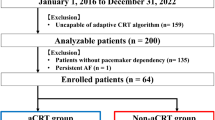Abstract
Automatic postventricular atrial refractory period (Auto-PVARP) is a dynamic interval designed to provide a longer PVARP at slower rates to enhance protection against pacemaker tachycardia (PMT) and a shorter PVARP to enhance atrial sensing at high rates. Auto-PVARP is often programmed in Medtronic devices for cardiac resynchronization therapy (CRT) with little knowledge of its intricate manifestations and disadvantages. The use of Auto-PVARP is contradictory to the universal teaching that CRT devices should be programmed with a short PVARP. We present the sequential ECGs of a patient with a CRT device programmed with Auto-PVARP in whom the atrial rate was increased with isoproterenol to simulate exercise. The recordings demonstrated that Auto-PVARP produced a substantial delay in the restoration of AV synchrony from the time the spontaneous atrial rate dropped below the programmed upper tracking rate. Auto-PVARP makes little sense (especially in the presence of first-degree AV block) in CRT patients considering that PMT is rare in this situation. In CRT patients, one should program a short and fixed PVARP of ≤ 250 ms.
Zusammenfassung
Die automatische variable postventrikuläre atriale Refraktärzeit („postventricular atrial refractory period“, Auto-PVARP) ist ein dynamisches Intervall. Es soll bei niedrigeren Frequenzen längere PVARP gewährleisten und so vor Schrittmachertachykardie („pacemaker tachycardia“, PMT) schützen, bei hohen Frequenzen dagegen sollen kürzere PVARP das atriale Sensing verstärken. In Medtronic-Geräten zur kardialen Resynchronisierung („cardiac resynchronization therapy“, CRT) ist häufig eine Auto-PVARP programmiert, allerdings mit unzureichenden Kenntnissen zur Funktion im Einzelnen und zu spezifischen Nachteilen. An dieser Stelle widerspricht der Einsatz des Auto-PVARP dem umfassenden Konsens, dass in CRT-Geräten kurze PVARP-Intervalle voreingestellt werden sollten. Wir stellen sequenziell angefertigte EKG-Aufnahmen eines Patienten mit einem Auto-PVARP-CRT-Gerät vor. Zur Simulation einer Übungsbelastung war die Vorhoffrequenz dieses Patienten mit Isoproterenol erhöht worden.. In den EKG-Aufnahmen zeigte sich, dass es durch Auto-PVARP nach Abfall der spontanen Vorhoffrequenz unter die programmierte obere Frequenz („tracking rate“) zu einer deutlich verzögerten Wiederherstellung der AV-Synchronizität kam. Angesichts der Tatsache, dass eine PMT in dieser Situation bei CRT-Patienten selten auftritt, ist eine Auto-PVARP nicht sinnvoll (vor allem bei einem AV-Block ersten Grades). Für CRT-Patienten sollte die PVARP kurz sein, nicht variabel und auf ≤ 250 ms programmiert werden.






Similar content being viewed by others
References
Barold SS, Herweg B, Giudici M (2005) Electrocardiographic follow-up of biventricular pacemakers. Ann Noninvasive Electrocardiol 10:231–255
Barold SS, Herweg B (2005) Upper rate response of biventricular pacing devices. J Interv Card Electrophysiol 12:129–136
Sweeney MO (2008) Programming and follow-up of CRT and CRT-D devices. In: Barold SS, Ritter P (eds) Devices for cardiac resynchronization. Technologic and clinical aspects. Springer, New York, pp 317–423
Burri H, Sunthorn H, Shah D, Lerch R (2006) Optimization of device programming for cardiac resynchronization therapy. Pacing Clin Electrophysiol 29:1416–1425
Technical manual for InSync III Device Model 8042, Medtronic Inc, Minneapolis, MN. 2006
Barold SS, Ilercil A, Leonelli F, Herweg B (2006) First-degree atrioventricular block. Clinical manifestations, indications for pacing, pacemaker management & consequences during cardiac resynchronization. J Interv Card Electrophysiol 17:139–152
Conflict of interest
The corresponding author states that there are no conflicts of interest.
Author information
Authors and Affiliations
Corresponding author
Rights and permissions
About this article
Cite this article
Barold, S., Stroobandt, R. Using devices with a variable postventricular atrial refractory period for cardiac resynchronization. Herzschr. Elektrophys. 23, 52–55 (2012). https://doi.org/10.1007/s00399-012-0167-0
Published:
Issue Date:
DOI: https://doi.org/10.1007/s00399-012-0167-0
Keywords
- Cardiac resynchronization
- Heart failure
- Postventricular atrial refractory period
- Cardiac pacemaker automaticity
- Atrioventricular block




